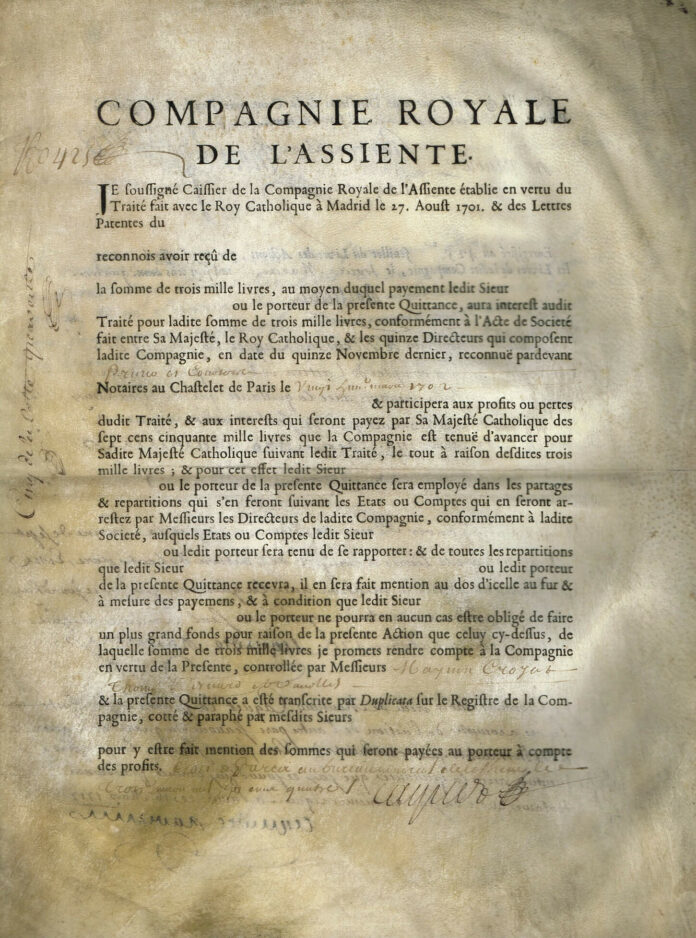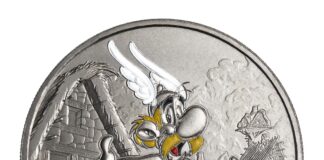
What was the highest priced scripophily sale at auction in 2018? Was it an American stock certificate, a German Aktie, or maybe a Chinese government bond? None of these. It was a French share and it was sold in Boone’s 60th Auction, at Antwerp on April 14, 2018.
Top sale in 2018, reported by the International Bond & Share Society (IBSS), was a 3000 Livres share from the Compagnie Royale de l’Assiente, issued in 1704. The company was created in Nov 1701 by King Louis XIV of France. On Aug 27, 1701, Philip V, King of Spain and Louis XIV signed a treaty granting France the exclusive privilege to supply the Spanish colonies in the Americas with African slaves. This right was called the “Asiento”. In 1713, the Compagnie Royale de l’Assiente lost the privilege to Great Britain and its slave-trading business was taken over by the South Sea Company.

With the exception of a 1664 share of the first Compagnie des Indes, this is the oldest French share certificate reported so far. Only one other similar share is known. The certificate, printed on vellum, has the signatures of several company directors, such as Antoine Crozat, Marquis du Châtel (c.1655-1738). Crozat, slave merchant and financial counselor to Louis XIV became the propriety owner of French Louisiana.
Consigned at the Boone auction of 14 April 2018, the share’s start price was set at €10,000. A historic certificate, it is an awful but important evidence of imperialistic slave-trading practises in the 18th century. The share was the best-selling item in the auction and reached €26,000, and that’s withouth the buyer’s premium.
The author Franky Leeuwerck also publishes articles on his blog and maintains an Internet Scripophily Museum of Computing.
Again and again, Franky Leeuwerck has supported CoinsWeekly by allowing us to republish his wonderful articles. If you enjoyed this one, we recommend you also read:
Hieroglyphs in Scripophily Deciphered
Antique securities from companies that operated in Egypt were typically illustrated using pharaonic themes and hieroglyphs. Standing on their own as true pieces of artwork, their mysterious designs made possible investors dream of promising outcomes. People bought these share certificates in the 19th and 20th century when the stock exchanges of Alexandria and Cairo flourished. But are the hieroglyphs on these certificates actually legible?
Twenty years of Belgas
“At first sight it looked like a rather plain certificate. But I was puzzled because it was not mentioning the familiar Belgian Franc as its currency denomination but Belgas. Thundering typhoons, what were Belgas?” Read Franky Leeuwerck’s intriguing article to learn more about it.
Scripophily and Numismatics
An enthusiastic scripophilist tells us more about the basics of his hobby and the close relation of numismatics and scripophily…
Kawasaki in the year 2889
Scripophily expert Franky Leeuwerck conducted a thought experiment. In 2889, an archaeologist, who has specialized in 20th century financial artefacts, finds a Japanese share from 1921. How does he react, what information can he retrieve from this document?
If you are interested in the medals of Louis XIV, you can find a beautiful selection in this press release.




